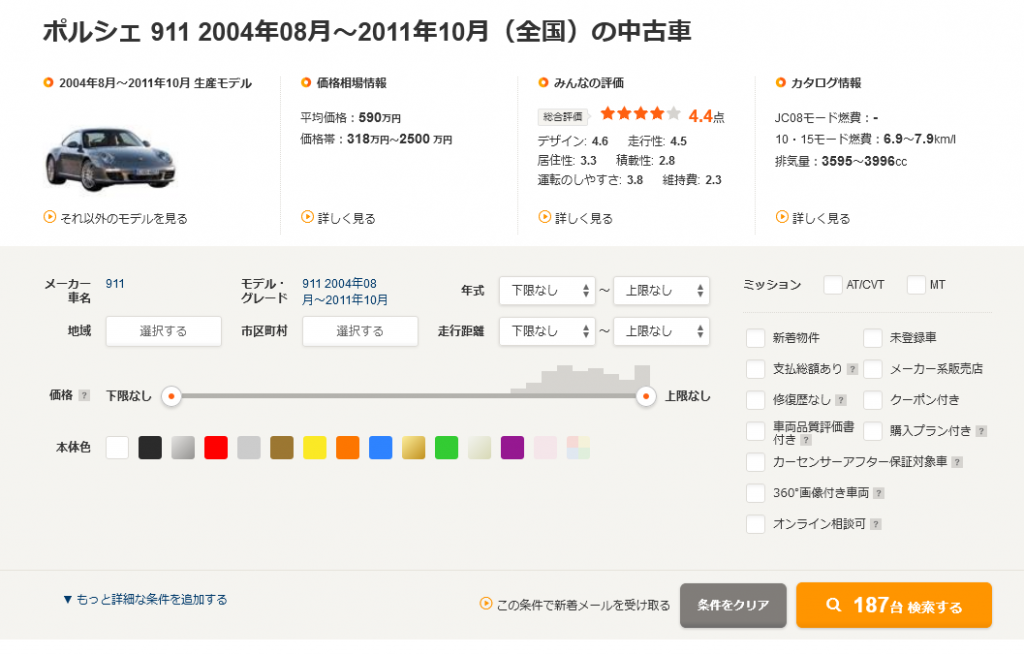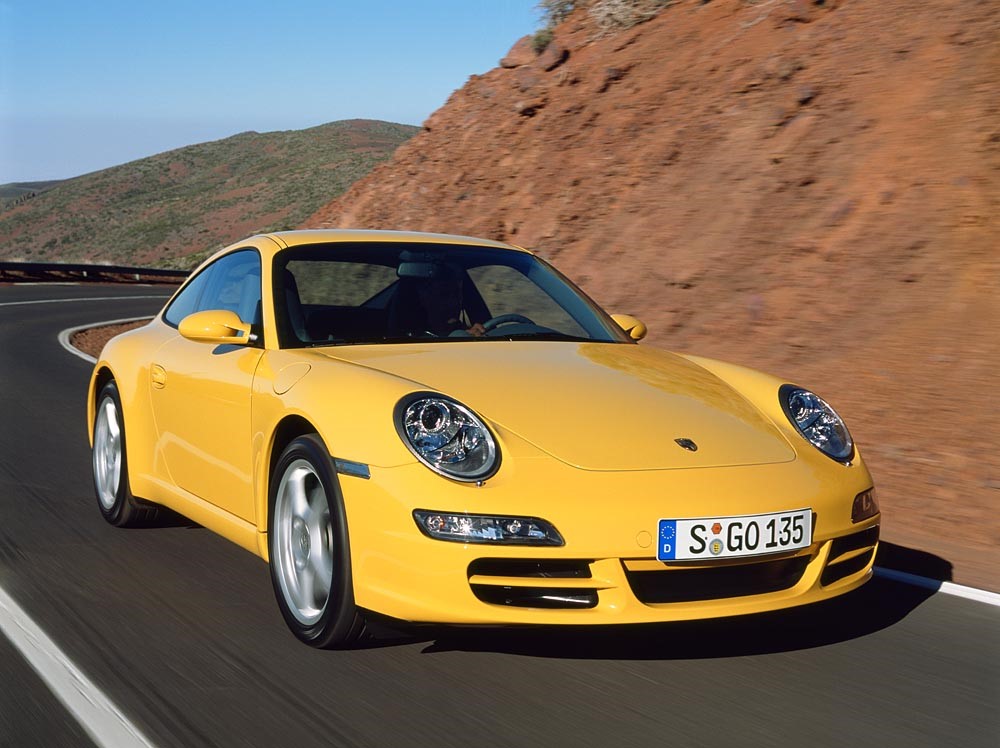997型なら180台以上から選択可能

前回の「996型」に続いて、今回は「997型」の中古車について書いていこうと思います。
参考にさせていただいているのは毎度お馴染みカーセンサーの中古車情報サイトですが、細かな条件で検索が出来るのでまだ条件を決めきれずに中古車探しをしている僕にとっては非常にありがたいです。
中古車探しといえば、今はこうしてネットですぐに探すことが出来ますが、僕が初めて車を購入した頃は「中古車情報誌」を購入して探していましたね。
世の中はどんどん便利になっていくなーと思った次第です。
さて、997型のポルシェ911ですが、前回調査した996型が90台の登録だったのに対して、997型は「187台」の登録がありました。
その台数は996型の倍以上で、一気に選択肢が広がった気がします。
ですが、ここで気になったのが、なぜ997型に対して996型の中古車がそんなに少ないのかということで、根本的に日本国内で販売された台数が少なかったからなのか、それとも登録から年数が経過し様々な事情により残念ながら廃車となってしまった車が多くなっているのか。
日本国内における過去のポルシェ911の販売台数についてのデータが無いのでハッキリとしたことは分かりませんが、昔に比べるとポルシェを見かける機会は増えたなと感じるので、恐らく販売台数は増えているのではないかと思います。
結果として、それが中古車登録台数の差として現れている気はします。(間違っていたら申し訳ありません)
補足
2005年以降のデータがあったので補足しておきます。
「ポルシェ」全体での台数なので、911だけでなくボクスターやカイエン、マカンなども含めた台数になりますが、10年くらい前と比べて約2倍に増えているようですね。
| 登録年 | 輸入台数 |
| 2005年 | 3,572 |
| 2006年 | 3,647 |
| 2007年 | 4,204 |
| 2008年 | 3,864 |
| 2009年 | 3,214 |
| 2010年 | 3,335 |
| 2011年 | 3,658 |
| 2012年 | 4,661 |
| 2013年 | 4,869 |
| 2014年 | 5,385 |
| 2015年 | 6,690 |
| 2016年 | 6,887 |
| 2017年 | 6,923 |
| 2018年 | 7,166 |
| 2019年 | 7,192 |
| 2020年 | 7,284 |
| 2021年(1~5月分のみ) | 3,257 |
もうひとつ、程度のいい日本の中古車(ポルシェだけでなく日本車も)がどんどん海外に流れているという話も聞いたことがあるので、それもひとつの原因なのではないかと考えています。
昨年、ポルシェ911の相場が一時的に下がっていた時期があったそうですが、国内の新型コロナウイルス感染拡大の影響だけでなく、海外バイヤーが来日できずに在庫がダブついていたのも原因だそうで、やはり海外市場の影響を大きく受けているのではないかと考えてしまいます。
997型ポルシェ911を狙うなら、前期型か?それとも後期型か??

引用元:AUTONEWS
180台以上が登録されている997型ポルシェ911ですが、996型で採用された「涙目型」のヘッドライト形状から伝統の「丸目」へと回帰することとなり、現行の992型でも丸目のヘッドライト形状が採用されているため、パッと見ただけではその車がポルシェであることは認識できたとしても、いったいどのモデルなのかはある程度詳しい人にしか分からないんじゃないかと考えていて、実際に僕自身もこうして様々な年代のポルシェ911を調べ始めてやっとその違いが明確になったくらいです。
発売から15年以上が経過しているにもかかわらず、古臭さを感じさせないデザインも大きな魅力の一つでもあります。
そんな997型ポルシェ911ですが、トランスミッションに「ティプトロニックS」が設定されていた前期型と、「PDK(Porsche Doppelkupplung)」が設定されていた後期型の2つに分けることが出来ます。
日本国内だと2009年の途中でティプトロニックS採用の前期型とPDK採用の後期型に分かれるようですね。
前期型と後期型でトランスミッションが大きく異なる997型ポルシェ911ですが、前期型が一つ前のモデルである996型と基本的に同じエンジンを搭載しているのに対して、後期型では完全新設計のエンジンを搭載することとなっており、同じ997型ではあるものの、前期型と後期型ではかなり中身は違ったものになっているようです。では、前期型と後期型のどちらがいいのか?と考えるわけですが、ここで少しPDKの話を書きたいと思います。
現在、僕が所有している車はフォルクスワーゲンのトゥーランという車で、トランスミッションは「DSG」と呼ばれるものが採用されているのですが、トゥーランに搭載される「DSG」もポルシェ911に搭載される「PDK」も広い意味ではどちらも同じ「DCT(デュアルクラッチトランスミッション・Dual Clutch Transmission)」なわけで、それぞれ使用する条件を考慮して専用の設計はされているのですが、基本的な構造や動作の仕組みは同じだと考えていいと思います。
この「DCT」ですが、細かい構造などは各自でお調べいただくとして「とにかく優秀」なトランスミッションで、MTで行うクラッチ操作を機械が代わりに行ってくれて、なおかつそのスピードが超早いというもの。
かつて、BMWがMモデルで採用していたSMGやRUFにも同じような自動クラッチ?のトランスミッションがありましたが、市販車に広く使われる技術ではなかったようです。
そのネガティブな部分を無くして、MTのダイレクト感を残したまま、ATの扱いやすさを持つトランスミッションが登場したということで、ついに来たかと意味もなく喜んでいたのを思い出します。
ですが、しばらくはDCT採用の車を所有する機会はなく、現在のトゥーランで初めてDCTの車を所有することとなるわけですが、初めて試乗したときに感じたのは「シフアップの早さ」と滑らかさで、滑らかといっても普通のATやCVTとは違ったギアとギアがダイレクトに繋がる感触もありながらの滑らかさで、「さすがDSG」と感心したものです。
そんな優秀なDSGですが、機械がクラッチ操作を行うということで、発進時に自分が思うのと微妙に違うクラッチの繋がり方をする場合があり、アクセルワークに気をつけないと急にクラッチが繋がり急発進したような状態になったり、低速走行時(特に2速での走行時)に上のギアへシフトアップしようかどうか迷っているような挙動で少しギクシャクしてしまう場面もあります。
そんな時は少し余分にアクセルを踏み込んで3速にシフトアップさせてあげるとスムーズに走行できますね。
あとは少し勾配のある坂道で停止してから右折や左折をする場面も苦手なようで、クラッチの繋がり具合を伺いながらアクセルをそーっと開けていくという動作が必要になります。
文章で書くとなんだか面倒くさい感じを受けますが、たぶん僕が気にして運転し過ぎなんじゃないかと思います。
何人か友人に運転してもらったこともありますが、誰も僕が感じたようなことを言う人間はいなかったので、気にしなければ普通のATと同じように運転できる優秀なトランスミッションだと思います。
話をポルシェ911に戻しますと、997後期型以降のポルシェ911はPDKを採用しているので、もしPDKのモデルを購入した場合は発進時や低速時、そして坂道などは少し気をつけながら運転しようと考えています。
補足しておくと、残念ながら日常的にMT車を運転できるほどMTの操作に慣れているわけではないので、ポルシェ911を購入するのであれば「AT」が僕の選択肢となります。
「スポーツカーなのにAT???笑」というのは無しでお願いします...
997前期型ポルシェ911には「インタミ問題」「6番シリンダー問題」も
DCTの話が長くなりましたが、997型ポルシェ911を検討する中で、避けて通ることが出来ない問題があり、ひとつはエンジン内部にある「インターミディエイトシャフト(IMS)」のベアリング破損により最悪の場合はエンジン乗せ換えとなる可能性もある通称「インタミ問題」。
そして、もう一つが「6番シリンダー問題」。
どちらも997型だと前期モデルで発生するトラブルのようですが、同じエンジンを採用している996型でも同様の問題が発生しているようです。
ただ、インタミ問題については途中で対策品のベアリングに変わっているようで、それ以前のものでもサービスキャンペーンにより対策品への交換が進められているとのことなので、対策がされているのであれば余り気にする必要は無さそうです。
問題なのは「6番シリンダー問題」で、こちらは今のところポルシェとしてリコールやサービスキャンペーンは実施されていないようで、997前期型を購入するのであれば、そのあたりをしっかり確認できる販売店で購入しないとなと思っています。
Porsche 911, there are twice as many used 997's as 996's out there!
For Type 997, you can choose from over 180 units.

Following the previous article on the 996, this time I'd like to write about the 997 used cars.
I'm referring to the familiar Car Sensor used car information site, which is very helpful for me as I'm still searching for a used car without being able to decide on a specific condition.
Speaking of looking for a used car, nowadays you can quickly search for one on the Internet like this, but when I first bought a car, I used to buy a used car information magazine to look for one.
The world is becoming more and more convenient, I thought.
Now, the 997 Porsche 911, the 996 model that I surveyed last time was registered 90 units, while the 997 model was registered "187 units".
This number is more than double that of the 996, and I feel that my options have expanded at once.
However, I was wondering why there were so few used cars of the 996 compared to the 997. Is it because the number of cars sold in Japan was fundamentally small, or are there more cars that have unfortunately been scrapped due to various reasons after years of registration?
I don't have any data on past Porsche 911 sales in Japan, so I don't know for sure, but I do feel that there are more opportunities to see Porsches than in the past, so I think the number of sales is probably increasing.
As a result, I think this is reflected in the difference in the number of used cars registered. (I apologize if I am wrong)
Another thing I've heard is that more and more good Japanese used cars (not only Porsches but Japanese cars as well) are going overseas, so I think that might be one of the reasons.
Last year, I heard that there was a time when the market price of the Porsche 911 temporarily dropped, but it was not only due to the influence of the spread of the new coronavirus infection in Japan, but also due to the fact that overseas buyers could not come to Japan and there was a glut of inventory.
If you want to go for the 997 Porsche 911, is it the earlier model? Or the late model?

Cited from: AUTONEWS
The 997 Porsche 911, of which more than 180 units have been registered, has returned to the traditional "round eyes" headlight shape from the "teary-eyed" headlight shape adopted in the 996 model, and even the current 992 model has adopted a round-eyed headlight shape, so you can recognize that the car is a Porsche just by a quick glance. I think that even if you can do it, only people who know a certain amount about which model it is, and in fact I myself started to look into the Porsche 911 of various years like this, the difference finally became clear.
Even though it has been on the market for more than 15 years, one of its major attractions is its design, which does not look old-fashioned.
It is such a 997 Porsche 911, but the transmission "Tiptronic S" was set to the early model, and "PDK (Porsche Doppelkupplung)" was set to the late model can be divided into two.
In Japan, it seems to be divided into the early model adopting Tiptronic S and the late model adopting PDK in the middle of 2009.
It is 997 Porsche 911 that the transmission differs greatly in the early model and the late model, but while the early model is equipped with basically the same engine as the 996 model that is one of the previous models, the late model will be equipped with a completely new engine design, and although it is the same 997 model, the early model and the late It seems that the contents have become quite different in the type 997. Then, which is better, the early type or the late type? I think, I would like to write a little PDK story here.
The car I currently own is a Volkswagen Touran, and the transmission is called "DSG", but both "DSG" installed in the Touran and "PDK" installed in the Porsche 911 are the same "DCT (Dual Clutch Transmission)" in a broad sense. In a broader sense, both the DSG in the Touran and the PDK in the Porsche 911 are the same "Dual Clutch Transmission" (DCT), and although each has been designed specifically for the conditions under which it is used, I think it is safe to say that the basic structure and mechanism of operation are the same.
The "DCT" is an "excellent" transmission, as you can find out the details of its structure on your own.
There used to be a similar automatic clutch transmission in the SMG and RUF that BMW used in their M models. However, this technology was not widely used in production cars.
I remember that I was unintentionally happy that a transmission with the ease of handling of an automatic transmission while retaining the direct feeling of a manual transmission had finally arrived, eliminating the negative aspects.
However, I didn't have a chance to own a car with a DCT for a while, and the current Touran is the first car I own with a DCT, but when I test drove it for the first time, I felt the "quickness of the shift up" and the smoothness. I was impressed by the smoothness and the direct connection between gears, which is different from a normal AT or CVT.
If you are not careful with the accelerator pedal work, you may feel as if the clutch is suddenly connected and the car is taking off suddenly. If you are not careful with the accelerator pedal work, the clutch will suddenly connect and the car will suddenly start to move.
In such cases, you can press the accelerator pedal down a little extra to shift up to 3rd gear for smoother driving.
The car also seems to have difficulty in turning right or left after stopping on a slope with a slight incline, so it is necessary to gently open the gas pedal while checking the clutch connection.
Writing about it in a sentence makes it sound like a hassle, but I think I'm probably driving with too much attention to it.
I've had a few friends drive it, and none of them said anything like what I felt, so I think it's an excellent transmission that can be driven just like a normal AT if you don't mind it.
Returning to the Porsche 911, the late 997 model and later Porsche 911s use PDK, so if I buy a PDK model, I will drive it with a little care when starting, at low speeds, and on hills.
Unfortunately, I'm not used to driving a manual transmission on a daily basis, so if I were to purchase a Porsche 911, the AT would be my choice.
I'm not so used to driving a manual transmission that I can't drive it on a daily basis. I'm not used to driving a manual transmission as much as I am used to driving a manual transmission.
Early 997 Porsche 911 also has "IMS problem" and "Number 6 cylinder problem".
The DCT has become a long story, but while considering the 997 Porsche 911, there are problems that can not be avoided, one of which is the "Intermediate Shaft (IMS)" bearing damage inside the engine, in the worst case, the engine may be replaced, commonly known as the "IMS Problem". The other is the "Number 6" problem.
And another is the "No. 6 cylinder problem.
Both of these problems seem to occur in the earlier 997 models, but it seems that the same problem is also occurring in the 996 models that use the same engine.
However, it seems that the problem has been changed to the bearing of the countermeasure in the middle of the IMS problem, and even before that, the replacement to the countermeasure is being promoted by the service campaign, so if the countermeasure has been taken, there is no need to worry too much about it.
The problem is the "No. 6 cylinder problem", this is a recall and service campaign has not been carried out as of now as Porsche, if you buy the 997 early type, I think you have to buy it at a dealership that can confirm that well.
Translated with www.DeepL.com
























